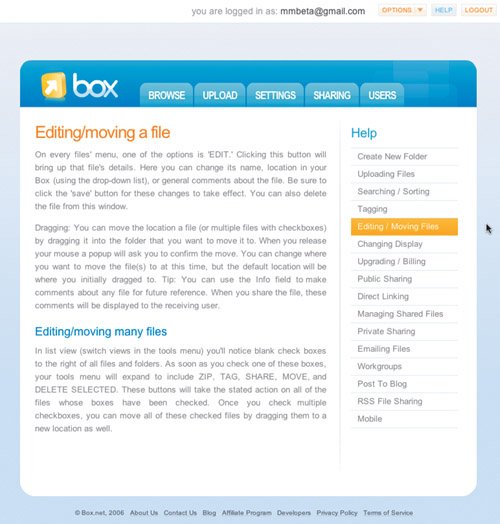Provide Help Documents, Because Help Is for Experts
| Jensen Harris, who works on the Microsoft Office team, once talked on his blog about how infrequently users access help documentation (this post is available at blogs.msdn.com/jensenh/archive/2005/11/29/497861.aspx). Instead of jumping to the help files any time a user needs to understand something new, he'll attempt to learn the procedure himself. As counterintuitive as it may be, expert users are actually the ones most likely to check help files. My own usability testing experiences confirm this. It's extremely rare for a new or intermediate user to dig through or even seek out the provided help documentation. (It's actually pretty shocking how infrequently users rely on help documents. A recent usability session on a fairly complicated application, where users were in constant need of assistance, showed that not one of the five testers looked for help articles. One of them even said she wished help was available, but never looked for it, despite the fact that a link to it was prominently displayed in the main interface.) Harris tries to explain this in the context of his own history. When he made the move to the Office team, he immediately went to a bookstore to buy a book on Excel to increase his skills instead of relying on help documentation. He believes this lack of interest in help is the result of several factors. First, there is a language barrier in help documentation. Users may be in exploratory mode, but they likely won't know the terminology they need to locate the right information. Most help systems don't produce search results nearly as well as Google, and users are often limited to using exact terminology and feature names to find what they need. This doesn't work when you're new to an application, and often fails even if you're an intermediate user. Experts, on the other hand, know the lingo used by an application and can quickly find specific information within a help system. Second, help documentation generally lacks the personality usually found in books and articles on the same subjects. Help files are meant to be technically accurate and concise, but authors of books and articles can loosen up and inject humor and liveliness into a piece to bring the material to life in a way help files usually cannot. Finally, the Web itself is one of the greatest help resources around, and many people latch onto it because the voice found there is more appealing. Online articles, forum posts, and blogs full of information on features and examples are as easy to find as a simple search through Google. These authors are not held back by the same constraints most tech writers face, so the information found there can be of greater use, as it's easier to digest information wrapped in a friendly package. For these reasons, the more effective approach to teaching new users how to move around in your application is to apply the techniques outlined earlier in this chapter. But when you do get some expert users, help documentation can be the perfect thing to keep them happy and motivated to learn more. Backpack provides a nice example of how help documentation can be done well. First, it doesn't focus on terminology exclusive to the application. (This is true mainly because the application itself is so simple and easy to understand.) Second, it is written with a personal tone and reads as if it'sp a tech-savvy friend standing over your shoulder answering questions. An added bonus is that the help documentation is entirely contained inyou guessed ita Backpack page, which means it stays in context, and thus continues displaying the list of Backpack pages you created so you can immediately jump back into the application. Putting users at ease like this lowers the perceived learning curve and answers questions without a lot of hassle. Box.net does something similar. Instead of providing an elaborate help system that requires a relatively deep understanding of the software, it offers a single-screen help page. The right side of the page features a simple vertical navigation bar made up of all the available topics. Just click and read! Box.net offers a box full of help content in this single-screen interface that serves up content without a single page refresh.  While applications should really be designed for intermediate users, it's important to keep experts happy as well, for they are the people who have invested the most time and energy into learning and using our applications. To this end, a little well-designed and well-written help can go a long way. |
EAN: 2147483647
Pages: 81
- Chapter I e-Search: A Conceptual Framework of Online Consumer Behavior
- Chapter VI Web Site Quality and Usability in E-Commerce
- Chapter VIII Personalization Systems and Their Deployment as Web Site Interface Design Decisions
- Chapter XII Web Design and E-Commerce
- Chapter XV Customer Trust in Online Commerce